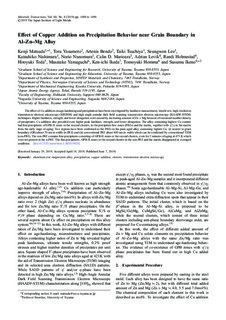Effect of Copper Addition on Precipitation Behavior near Grain Boundary in Al-Zn-Mg Alloy
Matsuda, Kenji; Yasumoto, Toru; Bendo, Artenis; Tsuchiya, Taiki; Lee, Seungwon; Nishimura, Katsuhiko; Nunomura, Norio; Marioara, Calin Daniel; Lervik, Adrian; Holmestad, Randi; Toda, Hiroyuki; Yamaguchi, Masatake; Ikeda, Ken-ichi; Homma, Tomoyuki; Ikeno, Susumu
Journal article, Peer reviewed
Published version

Åpne
Permanent lenke
http://hdl.handle.net/11250/2607243Utgivelsesdato
2019Metadata
Vis full innførselSamlinger
- Institutt for fysikk [2686]
- Publikasjoner fra CRIStin - NTNU [38011]
Sammendrag
The effect of Cu-addition on age-hardening and precipitation have been investigated by hardness measurement, tensile test, high resolution transmission electron microscopy (HRTEM) and high angle annular dark field scanning transmission electron microscopy (HAADF-STEM) techniques. Higher hardness, strength, and lower elongation were caused by increasing amount of Zn + Mg because of increased number density of precipitates. Cu addition also provided even higher peak hardness, strength, and lower elongation. The alloy containing highest Cu content had fine precipitates of GPB-II zones or the second clusters, in the precipitate free zones (PFZs) and the matrix, together with η′/η in the matrix from the early stage of aging. Two regions have been confirmed as the PFZs in the peak aged alloy containing highest Cu: (i) nearest to grain boundary (GB) about 70 nm in width (n-PFZ) and (ii) conventional PFZ about 400 nm in width which can be confirmed by conventional TEM (con-PFZ). The con-PFZ contains fine precipitates consisting of GPB-II zones or the second clusters, even for 2 minutes of aging at 473 K which were not present in the n-PFZ. The fine precipitates, GPB-II zones or the second clusters in the con-PFZ and the matrix disappeared at overaged condition.